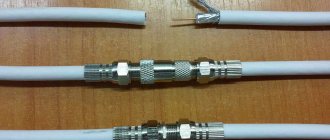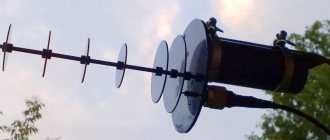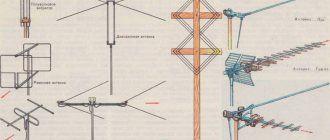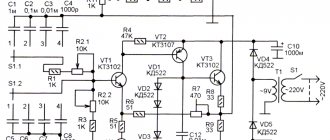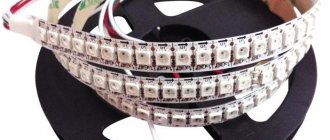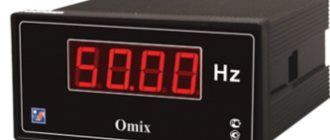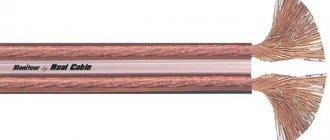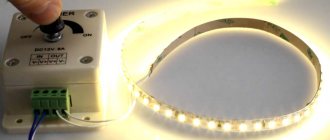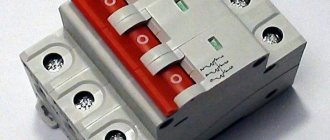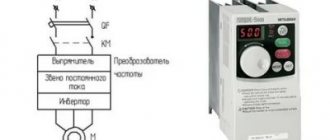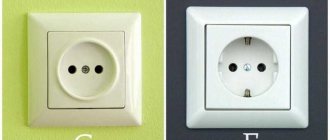The need for a receiver arises if there are two or more TVs installed at home. Another name for it is a divider, which is used to transmit television broadcasts to several televisions from one antenna. At the same time, the signal quality does not suffer in any way.
- What is an antenna splitter
- Types of TV splitters
- Active or passive TV splitter
- Characteristics of splitters
- How to choose a TV splitter
- How to connect an antenna cable splitter
- How to avoid a drop in signal level when installing a splitter
- Features of connecting to set-top boxes
- DIY antenna splitter
Types of TV splitters
There are several groups of splitters:
- Dividers, or splitters, are aimed at uniformly distributing the signal to the required number of TVs. Excellent for home cabling and is considered the most popular type. There are two types of splitters on sale: 5-1000 MHz (used for analogue or cable broadcasting) and 5-2400 MHz (suitable for satellite TV).
- Taps – used when you need to distribute a signal. For example, send the main part of it to one output, and send a weaker signal to the rest. This type is often used by cable network providers when installing apartment buildings.
- Adders are a type of splitter that can conduct a signal in the opposite direction while summing it. They mix multiple signals from wave receivers with different frequencies into one connector. Thus, you can connect cable and digital TV.
Also, splitters can be classified according to their purpose and method of signal processing:
- According to the functional purpose, the division of the splitter depends on the number of input connectors. There can be 2, 3, 4, 6 and 8.
- According to the method of signal processing: a regular splitter and with a signal amplifier.
Conventional splitters distribute the signal without additional processing. In this case, the quality of the broadcast is slightly lower if the signal went to one television receiver.
A splitter with a signal amplifier can correct this shortcoming. In this case, the received signal goes not to the TV, but to the amplifier, thus improving the image. This option will be an excellent solution if TV signals become too weak after connecting a splitter.
When choosing a splitter, you must take into account the number of TVs that it will serve.
How the splitter works
If you try to simply connect several wires in parallel to make a splitter for a television cable for 2 or 3 TVs with your own hands, you will get a poor signal with reduced contrast, a lot of interference and noise. This is due to the fact that any cable has an indicator called characteristic impedance, and it can only be connected to a component whose characteristic impedance is the same. That's why you need a special device - a splitter, since the cable cannot be connected to just anything.
You might be interested in Description of speaker cable
Types of splitters with different numbers of outputs
Note! If there is a high-quality signal, a conventional splitter is sufficient. A splitter is a passive separator, when passing through which the cable signal is attenuated in any case, and the attenuation is directly proportional to the number of output plugs.
Active or passive TV splitter
Although the output signal level remains high when using a splitter, it is attenuated. That is, if one TV is connected to the antenna, then the maximum amount of signal will go to it. If there are two of them, this signal will be divided into both TVs; if there are three, then each TV receiver will receive a third of the total antenna signal.
It is acceptable when the broadcast signal is initially high enough. But it often happens that the quality deteriorates greatly, interference and problems with the video appear.
When choosing a splitter, special attention should be paid to its parameters. If the signal quality does not improve, then an active splitter should be installed near the antenna. This will improve the signal quality and reduce the appearance of noise during playback.
An active splitter should be installed even if there is good audio and video playback, if the signal quality deteriorates when connecting a passive one.
To choose the right splitter, you need to decide on:
- Operating range and channels.
- The number of TVs that will be connected to it.
- Measure the cable cross-section.
| Active | Passive |
| Due to the built-in amplifier, it can be used on several outputs | Designed for two outputs without loss of quality properties |
| Requires an external power supply for the chip | Does not require external power supply |
| Used when there are problems with the quality of video and audio playback when connecting several TVs | Used to connect no more than two TVs at the same time, otherwise the image quality will deteriorate significantly |
The operating principle of an optical splitter. Case Study
Let's say we want to connect one floor from our house. Naturally, for this we installed optical distribution boxes on each floor. Now our task is to correctly install the optical fiber inside the ORC, and at the same time understand what role the splitter plays here?
General view of ORK:
Inside ORK:
The cable from the basement (ORSH) enters the floor (ORK) without termination, i.e. regular fiber without any connectors. Having slightly picked at the outer shell of the interfloor cable inside the ORC. (this is often called the “technology window”). We get the fiber.
Next, the fiber goes to the cassette, where welding (joint) occurs
After the joint in the cassette, we get the so-called pigtail from the fiber, i.e. This is a cable terminated on one side only - in our case it is a special SC connector. In practice, other types of connectors (FC, LC) can be used. On the other side there is exactly the same connector - the fiber from it goes to the splitter
Next, the cable from the pigtail goes to a 1x4 optical splitter (in this case). There it is divided into 4 fibers; in fact, it is at this moment that the splitter does its job.
After which the fibers again(!) go to the SC connectors, which are fixed in the upper part of the ORC.
From them there will already be a full-fledged patch cord, which will be extended to the subscriber and connected to the terminal device (optical terminal, as a rule)
Characteristics of splitters
Splitters are used when you need to connect several devices to one antenna. They differ from a splitter in the uniform division of the signal between TVs.
When choosing a splitter, you need to pay attention to:
- Number of outputs – determines the number of connected devices and the signal level for each.
- Design features - some have the form of a pipe with a soldered wire inside, while others are made in the form of a printed circuit board.
- Frequency range – any divider has a certain frequency range.
- Loss - this indicator indicates how much less the signal power at the output is than at the input.
- Insertion loss is the signal attenuation introduced by the divider itself.
- Maximum power – the maximum input power of the divider.
- Attenuation level – shows the level of signal power reduction. The lower this indicator, the less noticeable the losses will be.
Maksim
Equipment repairman
Ask a Question
Question to the expert
Which divisors are most in demand?
These are dividers with 2, 3 and 4 outputs rated at 29, 28 and 32 dB respectively.
Availability of amplifier
To maintain signal strength while increasing it, it is better to install a splitter with an RF amplifier. It is important to consider that this type of equipment requires an additional power source, without which it will not be able to perform its functions.
Bandwidth
This indicator indicates the frequency range in which the device can operate. A universal splitter is the frequency of which is 5-2500 MHz. It can connect to both terrestrial and analogue TV. Equipment with a frequency of 5-1000 MHz are used to improve the signal of broadcasting only.
Attenuation level
It is very important to take into account this indicator, which helps determine the level of signal power reduction. It is better to choose splitters with the lowest attenuation level, then the quality loss will not be so noticeable. The permissible value for two TVs is 3-3.5 dB.
When the image is no longer satisfactory
It happens that after introducing a splitter, the image quality on several TVs deteriorates. Some people get out of this situation by connecting a Polish antenna with an amplifier. And the second solution to the problem is to purchase a television splitter with an amplifier. The last method is good if before this the TV showed without any complaints and, in fact, there were no complaints about the antenna.
But a TV technician can give you more precise advice in this situation. It has devices for measuring signal strength. This is important to do because the image may also be distorted if there is too much signal in the background.
There are 3 ways to implement additional devices that increase signal strength:
- At high load transfer rates of the splitter, you can use one intermediate amplifier at the input to the splitter.
- If overload is likely, it is better to give preference to separate amplifiers at each output. And it is set independently at each output.
- Combined reinforcement. One is placed at the entrance and additional separate ones at the exits.
Splitters are widely popular devices these days. If there is more than one TV in the house, then you cannot do without such a device. Some craftsmen make such devices themselves. Someone, wanting to save money, buys Chinese splitters. But the safest thing to do is buy this item from a trusted manufacturer, and use the services of a teleworker for installation.
Today you rarely find an apartment with only one TV. Usually there are two or even three. And the subscriber has a question about how to connect all devices to one antenna cable. It would seem that an elementary tee splitter will allow you to send a signal to three digital broadcast TVs. In practice this is not always the case. A divider or splitter for DVB T2 digital television must be selected in accordance with the structure of the cable network in the house.
How to choose a TV splitter
A TV splitter is an antenna divider that is used when the signal from the antenna needs to be transmitted to several TVs at once. The device has built-in protection against incorrect surge voltage and current, which may exceed the norm during adverse weather conditions.
To select the appropriate equipment, you need to take into account the frequency that is used to watch channels, the number of TVs that will be connected to the splitter and the cable cross-section.
To choose the right divisor, you need to:
- Go to the TV menu and find out the frequency of all received channels. Then select the channel with the highest frequency and compare it with the divider frequency. For a splitter this figure should be higher.
- Consider the number of TVs connected to the splitter and choose the appropriate one.
- The attenuation of the fixture should be assessed. This indicator is indicated in the instructions or on the device body.
- Appearance and size. If the divider is located in a visible place, it should look neat.
- Fastening. It is best if it is possible to secure the device so that it does not hang on the wires.
- Connection method.
When purchasing, you should pay attention that a splitter, a diplexer or a coupler are often confused.
When the image is no longer satisfactory
It happens that after introducing a splitter, the image quality on several TVs deteriorates. Some people get out of this situation by connecting a Polish antenna with an amplifier. And the second solution to the problem is to purchase a television splitter with an amplifier. The last method is good if before this the TV showed without any complaints and, in fact, there were no complaints about the antenna.
But a TV technician can give you more precise advice in this situation. It has devices for measuring signal strength. This is important to do because the image may also be distorted if there is too much signal in the background.
There are 3 ways to implement additional devices that increase signal strength:
- At high load transfer rates of the splitter, you can use one intermediate amplifier at the input to the splitter.
- If overload is likely, it is better to give preference to separate amplifiers at each output. And it is set independently at each output.
- Combined reinforcement. One is placed at the entrance and additional separate ones at the exits.
Splitters are widely popular devices these days. If there is more than one TV in the house, then you cannot do without such a device. Some craftsmen make such devices themselves. Someone, wanting to save money, buys Chinese splitters. But the safest thing to do is buy this item from a trusted manufacturer, and use the services of a teleworker for installation.
A TV splitter is a special antenna divider. They are used in cases where there is more than one TV in the room and the signal needs to be distributed consistently between different consumers. A television splitter with an amplifier can serve a large number of devices at once (from 3 and above).
And if we talk about such devices, in general, they are necessary for frequency separation of channels. And also such devices additionally have built-in protection against incorrect pulse voltages and currents that may arise in the cable cores during a thunderstorm. The splitter also protects against interference from power transmission lines and contact networks of electric vehicles.
How to connect an antenna cable splitter
You can connect the splitter in several ways:
- a splitter with a screw clamp can be combined with a cable of any diameter;
- with threaded connection used in combination with thin cable;
- You can connect any cables to the coaxial sockets; regular antenna plugs are suitable for this;
Important! Some splitters require soldering.
The connection technology is as follows:
- Attach the splitter to the surface to be installed.
- On the antenna splitter, remove the rivets from each connector.
- Using a coaxial cable, connect the TV and the socket.
- Connect a common TV cable.
When purchasing a splitter for more outputs than there are TVs, you must temporarily turn off the unused ones, otherwise they will absorb excess voltage in the circuit.
Through a divider with matching
Matched dividers differ in bandwidth, i.e., for terrestrial TV the bandwidth will be 5-1000 MHz, and for satellite TV – 5-2400 MHz. Thus, a divider from terrestrial can be used for satellite, but not vice versa.
If the signal from the antenna is good, it is quite enough to use a passive splitter. It is much easier to use and will not lead to problems such as a burned out amplifier, problems with the power supply, etc.
For the amplification unit to operate, a constant connection to the power supply is required; without it, no current will flow into the antenna. That is why it is necessary to install a divider with access to power.
In this case, two receivers (digital TV or receiver) will be divided into active and passive. The active one will receive current through the antenna socket, and the passive one will receive the already processed signal.
To connect two or more TVs, you can use an active splitter with external power.
Through a regular splitter
If there is no passage for power, current can be supplied between the divider and splitter. As a result, current will be supplied to the amplifier, and the signal will go through a divider to the receiver. If you need to connect three or more TVs, you will need a splitter with the appropriate number of connectors.
Types of splitters and their main characteristics
[rek_custom1] All splitters are very similar to each other - they have a body made of metal and several connectors for connecting a cable. But, despite the similarity, each splitter model differs depending on its functional purpose:
- for 2 outputs;
- for 3 outputs;
- for 4 outputs;
- for 6 outputs;
- and a splitter for 8 outputs.
Each television splitter, regardless of the number of outputs it is intended for, has a high-throughput F connector , both for general and satellite TV. Moreover, depending on the device model, the surface of the outputs may have a silver or gold coating, due to which the level of signal strength loss is significantly reduced and the broadcast quality is improved.
The best device options are splitters that have an amplifier, high resistance and high frequency. Regardless of the antenna splitter model, all devices operate at a standard frequency - 5-1000 MHz for terrestrial TV, and 5-2500 MHz for satellite TV.
In addition, the connector markings are always present on the body of each device model:
- IN – input for an antenna entering the room;
- OUT – output for the cable that connects the splitter to each TV located in the room.
If you plan to purchase a splitter to connect a large number of TVs, you need to purchase an amplifier in advance to maintain image quality.
How to avoid a drop in signal level when installing a splitter
When installing a high-quality antenna and splitter on two TVs, the user may not always notice that the signal level has deteriorated. To avoid such problems, you can try:
- Install a passive signal amplifier. They are installed in front of the TV and do not require power. The device compensates for wave losses in the cable and is used when there are problems on individual channels.
- Use of active amplifiers. They are also mounted in front of the TV. This method is suitable if the signal drops to a level where channels are completely absent, and when searching, more than 20 channels are not detected, as well as other problems.
Varieties
Various types of structures are used, each of which has its own characteristics. When choosing, you need to take into account that the preference depends on the tasks facing the user.
Splitter
This device divides the incoming signal into the required number of consumers. At the same time, its characteristics change accordingly. This can be illustrated with the following example. If the input signal has a level of 12 dB, then when divided into two TVs, each of them will receive 6 dB. For three, this value will be equal to 4 dB.
The use of a threaded connection ensures a reliable connection Source stroy-podskazka.ru
Couplers
This design is used for signal conversion in apartment buildings. At the same time, it is distributed to each floor by splitters. And then to each apartment using taps. Here, two outputs are usually used, and the signal on one of them is more powerful. The latter can be used to connect another similar device. The cable from the weaker output will be used to transmit the signal to the apartment.
Adders
They can be used to simultaneously work with terrestrial and digital channels. It can only work with two consumers. If one of the receiving devices is disabled, it will still be possible to use the other.
Using different types of plugs Source stroy-podskazka.ru
Features of connecting to set-top boxes
One antenna can transmit a signal to several set-top boxes at once. You can do this using:
- Connecting two or more set-top boxes to a passive antenna.
- Connections via the receiver's loop output 1.
- Transfers power from the active antenna to the set-top box.
- Connections to the active antenna of two set-top boxes.
To connect a structure with a passive divider, the most ordinary antenna will do. The connection is made through an on-air divider into two or more TVs. The maximum possible number that can be connected to the antenna is eight TVs.
To connect more TVs, in addition to the divider, taps are installed in equal numbers.
There are cases when installing a divider on several TVs leads to a loss of power. In this case, a self-powered amplifier is installed at the input of the divider. The second set-top box can be connected through loop receiver 1, from where power will be transmitted to the active antenna.
To connect several set-top boxes to an active antenna, you need to install an amplifier. Without it, you won't be able to get a high-quality signal. It should also be noted that it works through a coaxial cable connected to the antenna.
If there is one set-top box, the power supply will come from the antenna socket; if there are several, it will be necessary to install special dividers, which have passages for power supply. Next, power from the set-top boxes goes to the divider, and then to the antenna amplifier.
Note:
- If the voltage of the antenna divider is more than 10V, then the connection may have a negative effect.
- If you install a matching device without an amplifier to a set-top box with active antenna power, it will fail.
Using dividers in an apartment
It is necessary to pay attention to the location of devices inside the apartment. The installation rules depend on the connection structure. It can be equilibrium or nonequilibrium. It is convenient to illustrate this with the following example.
Splitter for connecting three TVs Source paes250.ru
The television signal enters the apartment via one cable. The receivers are at the same distance from him. In this case, you can use a simple divisor. Which will divide the input signal into several identical ones.
If the TVs are located at different distances from the input cable, the connections will have different lengths. Thus, the closest signal will be of the highest quality, and the most distant signal will be of the least quality. There is a nonequilibrium structure here.
Scheme for using TV splitters Source 220v.guru
In this case, a coupler is used that will split the signal into two, one of which is strong and the other relatively weak. The last one is for the nearest TV receiver, and the other is for the next coupler. This scheme will allow you to get maximum video and audio quality on all available devices. Splitters will allow you to redistribute the power of the input signal.
When using a splitter, you must choose a suitable location for it. It is important to keep the cable length to a minimum. When using three or more TVs, the signal is expected to become quite weak. This will allow you to watch analogue channels, but not digital ones.
Antenna divider for two inputs with plugs Source art-liga.rf
For the latter, high signal quality is critical. In this case, it is recommended to use an active splitter. It will enhance the input signal to the required extent. It should be taken into account that signal amplification can also be done immediately after the antenna.
The more outputs the divider has, the stronger the attenuation will be. Therefore, it is not recommended to purchase a device that has more sockets for connection than necessary. If there are only two TVs, it is not recommended to take the device for 3 or more television receivers. When using it, not only signal weakening can occur, but also image ghosting. The latter is due to the presence of empty connectors. To avoid this effect, a plug with a resistance of 75 Ohms is placed on the free connector, which simulates a connected load.
Connecting a TV splitter Source stroy-podskazka.ru
DIY antenna splitter
It is best to buy a splitter in stores, and it is inexpensive. But you can make the design with your own hands. The splitter is a flat box, closed on top with a lid made of metal, iron and other materials.
Using screws and nuts, secure three regular connectors to the cover. Solder the radial outputs to the cover itself, so they will be connected to each other and make it possible to ensure electrical contact with the screen.
The splitter parts are soldered on the central pins of the TV connectors.
Matching of the central inputs of the connectors is carried out by installing a 150 Ohm resistor. You can make a transformer yourself by uniformly winding a wire with a diameter of 0.2-0.3 mm onto a ferrite ring (7-10 mm in diameter).
An antenna splitter is a real lifesaver when you need to connect several TVs to one antenna. But it should be taken into account that the more TVs are connected at the same time, the worse the signal may be. That is why it is necessary to install amplifiers, distributors and other devices that improve the quality of TV viewing.
